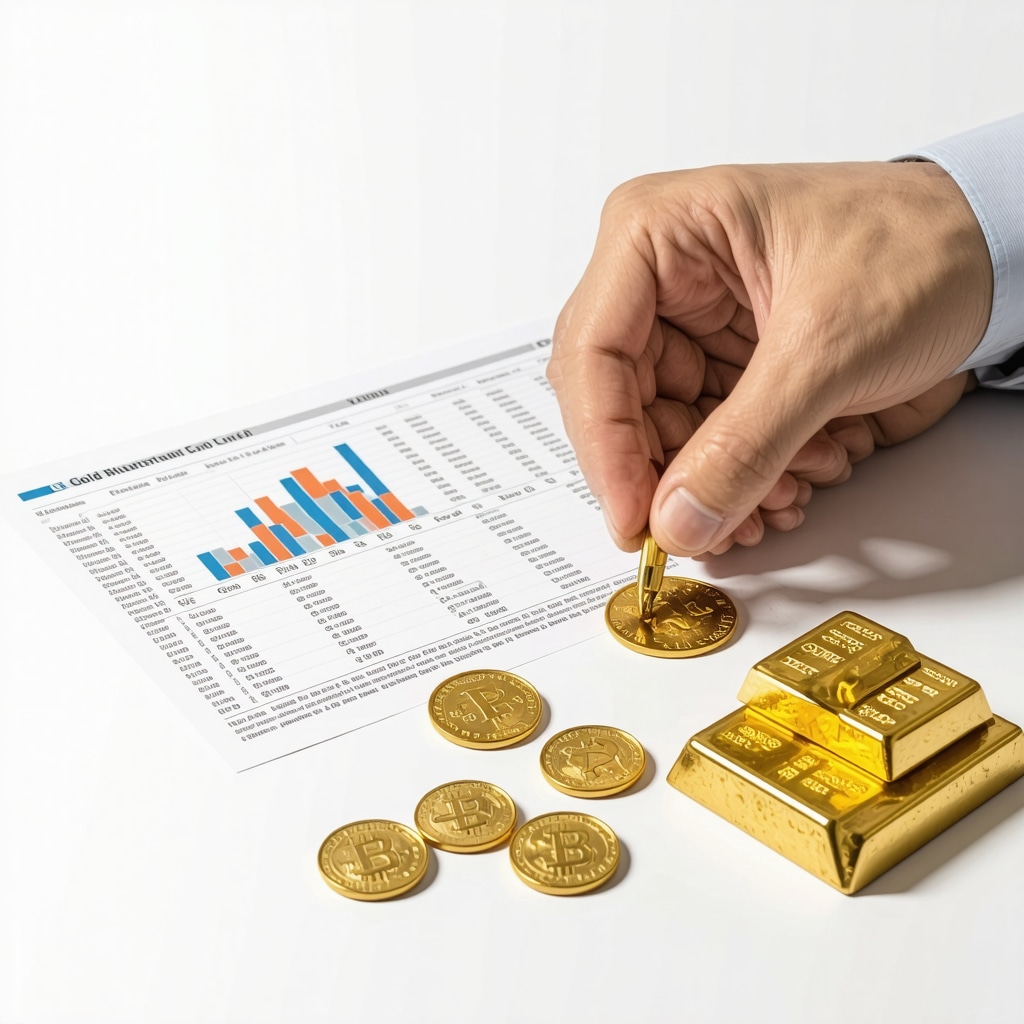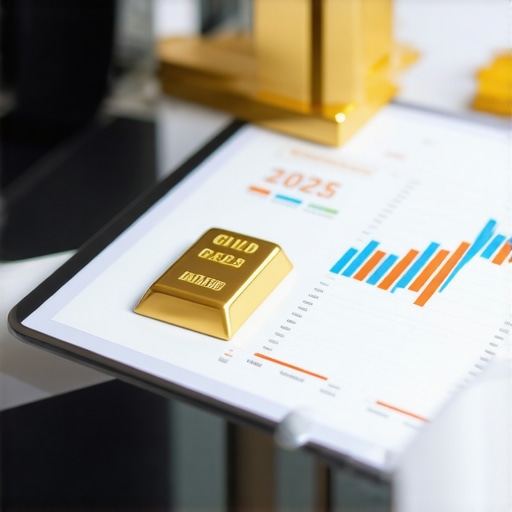Unlocking the Mysteries of Gold Investments: Mutual Funds vs ETFs
In an investment landscape riddled with volatility, gold stands out as a beacon of stability and long-term security. Yet, when it comes to investing in gold, discerning whether to choose a gold mutual fund or an exchange-traded fund (ETF) can be a complex decision. Both vehicles promise exposure to the allure of gold, but their structures, costs, and performance nuances significantly impact steady returns.
Decoding the Investment Vehicles: What Sets Gold Mutual Funds Apart?
Gold mutual funds pool investor capital to purchase shares in gold mining companies or physical gold indirectly. They offer professional management, often with active strategies aiming to outperform benchmarks. However, this active management incurs higher expense ratios, which can subtly erode steady returns over time. Moreover, the value of these funds may reflect operational risks and management decisions beyond gold price movements.
ETFs in the Spotlight: A Transparent and Cost-Effective Alternative
Gold ETFs typically track the price of physical gold or a gold index, offering a direct and transparent linkage to gold’s market value. Their passive management style results in lower expense ratios, often translating into better consistency in returns. For investors seeking liquidity and intraday trading flexibility, ETFs present distinct advantages. However, they lack the potential upside of actively managed mutual funds that might capitalize on market inefficiencies.
How Do Gold Mutual Funds and ETFs Compare in Terms of Risk and Return?
When analyzing risk-adjusted returns, gold ETFs generally exhibit lower volatility correlating closely with the spot gold price, thereby providing steady returns aligned with gold’s intrinsic market value. In contrast, gold mutual funds introduce additional layers of risk—such as mining operational risks and management performance—that can amplify fluctuations but also offer opportunities for excess returns. Historical data from reputable financial institutions like Investopedia illustrate that ETFs tend to be more predictable for conservative investors, while mutual funds may suit those with a higher risk appetite seeking active exposure.
Practical Insights: Real-World Scenarios Illuminating Your Choice
Consider an investor prioritizing steady, inflation-hedged returns without daily trading complexities. A gold ETF would provide seamless exposure with minimal costs and consistent tracking of gold prices. Conversely, a seasoned investor seeking growth beyond gold price appreciation might favor gold mutual funds, leveraging professional management to navigate market dynamics and mining sector trends.
For a comprehensive exploration of gold investment strategies tailored to market volatility, readers can delve deeper into this expert guide.
Building a Balanced Portfolio: Strategic Considerations for 2029 and Beyond
Integrating gold mutual funds and ETFs requires understanding portfolio objectives, risk tolerance, and time horizon. Diversifying between both might capture the steady tracking of ETFs and the potential alpha from mutual funds’ active management. Investors should also consider tax implications, liquidity needs, and expense ratios to optimize net returns.
Curious about the top gold ETFs and mutual funds tailored for conservative investors in 2029? Explore insightful recommendations here.
Ready to Optimize Your Gold Investment Strategy?
Understanding the nuanced differences between gold mutual funds and ETFs can empower you to make informed decisions that align with your financial goals. Share your experiences or questions in the comments below to engage with a community of savvy investors committed to steady returns through gold.
Reflecting on My Journey with Gold Investments
When I first dipped my toes into gold investing, the myriad of options was overwhelming. I remember juggling between gold mutual funds and ETFs, each promising unique advantages. Over time, I’ve realized that understanding their subtle differences is crucial—not just from a theoretical standpoint but also through lived experience.
For instance, investing in a gold mutual fund once felt like entrusting my wealth to seasoned professionals who could navigate mining sector ups and downs. However, the higher fees sometimes felt like hidden drag on my returns. Conversely, gold ETFs provided me with a sense of immediacy and transparency, allowing me to react swiftly to market changes with minimal costs.
Why Does Expense Ratio Matter More Than We Think?
One key realization during my investment journey was how expense ratios silently chip away at returns, especially with actively managed mutual funds. Even a seemingly small difference of 0.5% annually can compound significantly over years. This insight aligned with what I read on Investopedia, where they emphasize that ETFs often outperform mutual funds in net returns precisely because of their lower fees and passive management.
Understanding this helped me tailor my portfolio more thoughtfully, balancing the desire for active management with cost-efficiency. If you’re starting out, consider how expenses might affect your long-term growth—it could be a game-changer.
How Do You Decide Between Active Growth and Steady Stability?
Have You Ever Wondered Which Gold Investment Fits Your Personality and Goals Best?
For me, it boiled down to my risk tolerance and investment horizon. Early on, the allure of active growth through mutual funds attracted me. Yet, after experiencing market swings and fee impacts, I appreciated the predictability of ETFs for core holdings.
Ask yourself: Are you comfortable with potential volatility in exchange for the chance of higher returns? Or do you prefer a steadier ride that mirrors gold’s intrinsic value? There’s no one-size-fits-all, but reflecting on these questions can clarify your strategy.
Practical Tips from My Own Portfolio Adjustments
Recently, I diversified my approach by allocating a portion of my gold investments to ETFs for liquidity and low cost, while keeping a smaller stake in mutual funds to capture active management benefits. This blend helped me harness the best of both worlds.
If you’re curious about optimizing your gold holdings further, you might find value in exploring smart gold investment strategies for long-term portfolio growth. It provides actionable insights that complement my personal experiences.
Engage with the Gold Investment Community
I’m eager to hear from you—what has your experience been with gold mutual funds versus ETFs? Have you found a strategy that resonates with your financial goals? Sharing your journey can help others navigate this intricate landscape. Drop your thoughts in the comments or share this article with fellow investors looking to deepen their understanding of gold investments.
Maximizing Tax Efficiency: Navigating the Complexities of Gold Mutual Funds and ETFs
One of the most overlooked yet critical factors in optimizing gold investments is understanding the tax implications associated with gold mutual funds versus ETFs. This nuanced area significantly affects net returns and should be a core consideration for seasoned investors aiming to preserve wealth.
Gold ETFs, particularly those that hold physical gold bullion, are often classified as collectibles by the IRS in the United States, subjecting gains to a higher capital gains tax rate—up to 28% for long-term holdings—compared to typical equity investments. Conversely, certain gold mutual funds that invest in mining stocks may be taxed at standard capital gains rates, which can be considerably lower depending on the investor’s bracket.
Furthermore, mutual funds distribute capital gains annually, potentially triggering unexpected tax bills even if the investor hasn’t sold shares. ETFs, with their unique in-kind redemption mechanisms, tend to be more tax-efficient by minimizing capital gains distributions. However, this efficiency varies based on the fund’s structure and jurisdiction.
Investors should also consider state-level taxation and the impact of tax-advantaged accounts such as IRAs or 401(k)s when planning gold allocations. Consulting a tax advisor who specializes in commodities and precious metals can unlock tailored strategies to mitigate tax drag and enhance after-tax returns.
What Are the Advanced Tax Planning Strategies for Gold Investments?
Tax-loss harvesting is a sophisticated technique where investors sell gold holdings at a loss to offset gains elsewhere in their portfolio, reducing overall tax liability. Utilizing tax-deferred accounts to hold gold ETFs or mutual funds can defer taxes on gains until withdrawal, often at potentially lower income tax rates in retirement.
Additionally, some investors explore gold-focused exchange-traded notes (ETNs) or closed-end funds that might offer different tax treatments but come with their own risks and complexities. Understanding these subtleties requires a deep dive into fund prospectuses and tax codes.
For a comprehensive analysis of tax-efficient precious metals investing, the CFA Institute’s research provides authoritative insights grounded in rigorous financial scholarship.
Incorporating Gold Investments into a Holistic Portfolio: Beyond Simple Diversification
While gold is traditionally prized for its role as a hedge against inflation and market volatility, integrating gold mutual funds and ETFs requires a strategic approach that aligns with broader portfolio objectives. Advanced portfolio theory suggests that gold’s low or negative correlation with equities and bonds can enhance risk-adjusted returns when allocated thoughtfully.
However, the choice between mutual funds and ETFs within gold allocations can influence portfolio dynamics. Active gold mutual funds may introduce sector-specific risks and opportunities, such as exposure to mining operational leverage, geopolitical factors, and corporate governance considerations. This active exposure can diversify sources of returns but demands ongoing monitoring and expertise.
Gold ETFs, by mirroring the spot price of gold, provide pure metal exposure, which is effective for tactical asset allocation and liquidity management. Their intraday tradability allows investors to respond rapidly to macroeconomic events, a feature less accessible in mutual funds.
Balancing these instruments within the portfolio can achieve a nuanced blend of stability and growth potential. Risk budgeting techniques may allocate a fixed volatility or drawdown threshold to gold holdings, optimizing portfolio resilience without sacrificing upside participation.
How Can Sophisticated Investors Optimize Gold Allocation Using Advanced Portfolio Techniques?
Utilizing mean-variance optimization frameworks, investors can model expected returns, volatilities, and correlations of gold ETFs and mutual funds alongside other asset classes to identify efficient frontiers. Stress testing portfolios against macroeconomic shocks—such as stagflation scenarios or currency devaluations—further refines allocation decisions.
Dynamic rebalancing strategies that adjust gold exposure in response to changing market regimes or inflation expectations can enhance long-term outcomes. Employing options strategies on gold ETFs for downside protection or yield enhancement introduces additional layers of sophistication.
Leveraging Technology and Analytics for Superior Gold Investment Decisions
Modern investors benefit from powerful analytics platforms and algorithmic tools that analyze gold market trends, mining sector fundamentals, and macroeconomic indicators in real time. Sentiment analysis, machine learning models, and predictive analytics can uncover subtle signals that differentiate between when to favor active mutual funds versus passive ETFs in gold allocation.
In addition, blockchain technology is emerging as a means to increase transparency and security in gold ownership and trading, potentially influencing future investment vehicles and reducing counterparty risks.
Staying abreast of these technological advancements and integrating them thoughtfully into investment processes can confer a competitive edge in the complex gold market.
For investors aiming to deepen their expertise and harness cutting-edge tools, exploring specialized resources and fintech solutions tailored to precious metals is highly recommended.
Advanced Tax Strategies: Navigating the Intricacies for Maximized After-Tax Returns
For seasoned investors, understanding the nuanced tax landscape surrounding gold mutual funds and ETFs is paramount to preserving capital and enhancing net returns. The IRS’s classification of physical gold holdings, especially within ETFs, as collectibles imposes a distinct tax regime, often resulting in higher capital gains taxes compared to standard equity investments. Conversely, gold mutual funds, typically invested in mining equities, may benefit from more favorable long-term capital gains rates but carry the complexity of annual capital gains distributions, which can generate unexpected tax liabilities.
Deploying sophisticated techniques such as tax-loss harvesting allows investors to strategically offset gains by realizing losses within their gold holdings, thereby optimizing tax outcomes across the broader portfolio. Moreover, leveraging tax-advantaged accounts like IRAs or 401(k)s to hold gold investments can defer tax obligations, potentially aligning withdrawals with lower income tax brackets during retirement.
What Are the Most Effective Tax-Efficient Strategies for Gold Investment Vehicles?
Advanced strategies include utilizing in-kind redemptions available in ETFs to limit capital gains distributions and exploring alternative instruments such as gold-focused ETNs or closed-end funds that may present distinct tax profiles. However, these options require meticulous due diligence to weigh risks against benefits. For an authoritative exposition on these complexities, the CFA Institute’s research offers comprehensive guidance grounded in rigorous financial scholarship.
Integrating Gold Mutual Funds and ETFs Within a Sophisticated Portfolio Framework
Strategic incorporation of gold investments transcends mere diversification; it demands a holistic appraisal of asset correlations, volatility profiles, and macroeconomic sensitivities. Active gold mutual funds introduce exposure to mining sector idiosyncrasies, including operational leverage and geopolitical risks, potentially enhancing alpha generation but necessitating continual portfolio oversight. In contrast, gold ETFs deliver pure metal exposure with superior liquidity and intraday tradability, facilitating agile tactical allocation adjustments.
Employing risk budgeting techniques enables investors to allocate gold holdings based on volatility or drawdown constraints, harmonizing risk tolerance with return objectives. Furthermore, dynamic rebalancing informed by macroeconomic indicators—such as inflation expectations or currency fluctuations—can refine gold allocations to optimize portfolio resilience.
How Can Institutional Investors Employ Advanced Quantitative Models to Optimize Gold Allocations?
Institutional-grade portfolio construction leverages mean-variance optimization to balance expected returns against risk metrics, incorporating correlations not only between gold ETFs and mutual funds but also across diversified asset classes. Stress testing under adverse economic scenarios, including stagflation or geopolitical turmoil, informs allocation thresholds and hedging strategies. Additionally, overlaying options strategies on gold ETFs can provide downside protection or enhance income, integrating derivative instruments into the gold investment thesis.
Harnessing Cutting-Edge Technology and Data Analytics in Gold Investment Decisions
The integration of machine learning algorithms, sentiment analysis, and real-time macroeconomic data analytics is revolutionizing gold investment approaches. These technologies enable the detection of subtle market signals and predictive patterns that can inform the judicious timing between active mutual fund engagement and passive ETF exposure. Moreover, blockchain innovations are poised to transform gold ownership transparency and transactional security, potentially birthing new investment vehicles with reduced counterparty risk.
Investors seeking to capitalize on these advancements should explore specialized fintech platforms and analytical tools tailored to precious metals. Such integration empowers a data-driven, adaptive investment process that aligns with evolving market dynamics.

Engage with the forefront of gold investment expertise by exploring these advanced strategies and technological innovations. Share your perspectives or inquire further in the comments to join a community dedicated to elevating gold investment proficiency.
Frequently Asked Questions (FAQ)
What are the primary structural differences between gold mutual funds and gold ETFs?
Gold mutual funds typically invest in gold mining stocks or a mix of mining equities and sometimes physical gold indirectly, managed actively with the goal to outperform benchmarks. Gold ETFs generally track the spot price of physical gold or a gold index through a passive management approach, providing direct exposure to gold’s market price with intraday liquidity.
How do expense ratios impact long-term returns in gold mutual funds versus ETFs?
Expense ratios are critical since higher fees, common in actively managed gold mutual funds, erode returns over time through compounding effects. ETFs usually have lower expense ratios due to passive management, resulting in more cost-efficient exposure and often higher net returns for steady investors.
Which investment vehicle offers better tax efficiency for gold exposure?
Gold ETFs that hold physical bullion are often taxed as collectibles in the US, subjecting gains to higher capital gains tax rates (up to 28%). Mutual funds investing in mining stocks may incur lower standard long-term capital gains taxes but distribute gains annually, possibly triggering unexpected tax liabilities. ETFs’ in-kind redemption mechanisms often make them more tax-efficient overall, but this varies by structure and jurisdiction.
Can combining gold mutual funds and ETFs in a portfolio improve diversification?
Yes. ETFs provide pure gold price exposure and liquidity, while mutual funds add active management and exposure to mining sector dynamics. Blending both can balance steady metal price tracking with potential alpha from active management, enhancing risk-adjusted returns when aligned with investment objectives and risk tolerance.
How do market volatility and inflation expectations influence gold investment choices?
Gold traditionally acts as a hedge against inflation and market uncertainty. ETFs offer nimble, low-cost exposure ideal for tactical inflation hedging or volatility-driven trades. Mutual funds may outperform in certain mining cycles or geopolitical events through active management, but with increased risk and cost.
What advanced portfolio strategies can optimize gold allocations?
Techniques like mean-variance optimization, risk budgeting, and dynamic rebalancing based on macroeconomic indicators can refine gold exposure. Incorporating options strategies on ETFs for downside protection or yield enhancement further tailors risk-return profiles in sophisticated portfolios.
How can technology enhance gold investment decision-making?
Machine learning, sentiment analysis, and real-time macroeconomic data analytics enable detection of subtle market signals to optimize timing between active mutual funds and passive ETF exposure. Emerging blockchain solutions improve transparency and security in gold ownership, potentially transforming future investment structures.
What tax planning techniques can seasoned investors use to maximize after-tax gold returns?
Tax-loss harvesting to offset gains, utilizing tax-advantaged accounts like IRAs, and leveraging in-kind ETF redemptions to minimize capital gains distributions are effective strategies. Exploring alternative vehicles like ETNs or closed-end funds with different tax implications can also be part of an advanced tax-efficient portfolio.
Are gold mutual funds or ETFs better suited for beginner investors?
For beginners seeking simplicity, cost-efficiency, and transparency, gold ETFs are generally preferable due to lower fees and direct price tracking. Mutual funds require more nuanced understanding of mining sector risks and active management strategies, which may suit investors with greater experience and risk tolerance.
How should an investor choose between active growth and steady stability in gold investments?
It depends on risk tolerance, investment horizon, and financial goals. Active mutual funds may offer higher return potential but with volatility and fees, while ETFs provide stable, low-cost exposure that closely tracks gold prices. Reflecting on personal preferences and portfolio context guides the optimal choice.
Trusted External Sources
- CFA Institute – Offers rigorous research on the tax implications and portfolio integration of gold investments, providing foundational knowledge for sophisticated tax planning and asset allocation strategies.
- Investopedia – Provides clear, expert-reviewed articles that explain the pros and cons of gold ETFs and mutual funds, essential for understanding fee structures and investment mechanics.
- World Gold Council – The leading authority on gold market trends, providing valuable data and insights on gold demand, investment flows, and macroeconomic influences that inform strategic allocation decisions.
- Morningstar – Renowned for in-depth fund analysis and performance data, helpful in evaluating gold mutual funds and ETFs based on expense ratios, risk profiles, and historical returns.
- U.S. Internal Revenue Service (IRS) – Official guidance on taxation of precious metals investments, critical for understanding the complex tax treatment of gold ETFs and mutual funds.
Conclusion
Choosing between gold mutual funds and ETFs is a nuanced decision that hinges on understanding their structural differences, cost implications, tax considerations, and alignment with your portfolio objectives. Gold ETFs offer low-cost, transparent, and liquid exposure closely tied to the metal’s spot price, ideal for investors prioritizing steady, inflation-hedged returns. In contrast, gold mutual funds provide active management and mining sector exposure, opening avenues for potential alpha but accompanied by higher fees and risks.
Integrating both vehicles thoughtfully can harness the stability of ETFs and the growth opportunities of mutual funds, particularly when combined with advanced portfolio techniques such as risk budgeting and dynamic rebalancing. Moreover, leveraging technology and tax-efficient strategies enhances your ability to maximize after-tax returns and navigate market complexities.
Empower your investment journey by applying these expert insights, engaging with trusted resources, and embracing continual learning. Share your experiences or questions in the comments below, and explore our related expert content to deepen your mastery of gold investments for a resilient portfolio in 2029 and beyond.











This post offers a comprehensive comparison between gold mutual funds and ETFs, highlighting the importance of understanding underlying structures and costs. In my experience, I’ve found that while ETFs are more straightforward and cost-efficient for passive exposure, actively managed mutual funds can sometimes outperform in volatile markets if managed well. However, the key is aligning your choice with your risk tolerance and investment horizon. I’ve personally shifted a significant portion of my gold holdings into ETFs due to their transparency and tax advantages, but I still keep a small stake in mutual funds for diversification through active management. Have others found certain strategies more effective in managing operational risks or tax implications when blending these two vehicles? I’d appreciate hearing real-world insights and how you balance these options within your portfolio for steady returns.